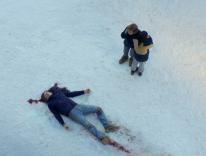Mel Gibson needs pain. You might retort that, lately, he’s made more than enough for himself, but I’m talking only about the pain that feeds his art, not the tabloids.
Two cravings seem to ignite his talent, yet also limit it: the need to imagine the very distant past in all its strangeness, and the urge to portray excruciating physical agony graphically. The blood that drenched The Passion of the Christ certainly made the Nazarene’s self-sacrifice palpable, and Gibson’s refusal to render the ancient world cozily familiar to us was refreshing. However, the incessant brutality became monotonous and, because the brief final scene of resurrection was perfunctory, the movie ended up impacted and sadomasochistic rather than cathartic. The Passion’s real drama took place in the first five minutes when Jesus resisted Satan’s urging him to abjure self-sacrifice. After that, we could only watch him suffer and die for 120 minutes.
The plot of Apocalypto contains no such pitfalls. It is the familiar tale of a good man in the clutches of a cruel foe, of the escape by foot from that foe, of pursuit through a jungle or wilderness (the pursued occasionally striking back at the pursuer with improvised weapons or traps), and of return to safety and loved ones. Think of true frontier narratives like Daniel Boone’s escape from the Shawnees, of the classic short story “The Most Dangerous Game,” and of that brilliant and still underrated action movie The Naked Prey. No theological transcendence awaits us at the end of this sort of story, merely a hairsbreadth escape and a gasp of relief. Precisely because Apocalypto’s plot is so much more limited and conventional than the great gospel mystery, it better suits Gibson’s talents and limitations: his flair for action, cruelty, and detailed exoticism, his lack of psychological depth. In other words, Mel doesn’t get in over his head here.
The script, by Gibson and co-producer Farhad Safinia, lays out the narrative in four chapters. First, we are introduced to the idyllic village life of a Central American tribe and to Jaguar Paw, son of the village chief, competent hunter, loving husband and father. This is the least interesting part of the film because Gibson cannot make such uncomplicated lives interesting. The family relationships are just so much banal, noble-savage stuff, and the joshing among the young hunters a loincloth version of Animal House. I couldn’t wait for disaster to strike.
It comes in the form of a raid by warriors of the Mayan Empire. (How do I know they were Mayan? I looked it up on the Internet.) The village is wiped out, the surviving women sold into slavery, the surviving men sacrificed, the children pathetically abandoned. The march to the Mayan capital is excruciating-each coffle has four or five men manacled by their necks to a single long iron bar so that the faltering stride of just one tortures the others-and as you watch this, you can feel Mel Gibson’s talent snapping to attention. When one captive loses his footing on a cliffside and dangles over an abyss with all the others straining their neck muscles to swing him back to solid ground, the director makes you feel in need of a chiropractor. But beneath the physical agony of Jaguar Paw is his emotional agony: he has left his pregnant wife and little son hidden in a pit back at the ruined village. What he meant as safekeeping became their trap when one of the invaders disposed of a necessary rope ladder. Jaguar Paw’s desperate need to survive so that he can rescue his family keeps the torture scenes dramatically moving even when they verge on sensationalism.
The third segment gives us the arrival at the Mayan capital and the blood sacrifice from which the hero is conveniently delivered by an eclipse of the sun. This sequence is saved from Cecil B. DeMille corniness by Gibson’s sheer delectation of pagan magnificence and cruelty. The visual realization of the city (great sets by Tom Sanders and Norman Marshall, wonderful costumes and masks by Mayes Rubeo, superb cinematography by Dean Semler) is never less than fascinating, and the details-a glittering temple prostitute spitting food out of her mouth as she laughs at some salacious joke, the heads of the victims tumbling from the altar down a chute and being caught in nets that resemble lacrosse sticks-contribute to the sort of exaltation of cruelty urged on us by Nietzsche’s vision of the Blonde Beast. But though this pagan city may have forgotten compassion, Gibson does not, for his camera keeps reverting to the face of Jaguar Paw, frightened, dazzled, never abandoning hope.
The final sequence, the escape of the hero and his pursuit through the jungle by the vengeful warrior Zero Wolf (frighteningly embodied by a wonderful specimen named Raoul Trujillo) is at once the most conventional and most satisfying part of the movie. For here Gibson’s craftsmanship pays off in a forty-five-minute sequence that contains every sort of stunt imaginable: leaps into waterfalls, encounters with wild beasts, hand-to-hand combat. It’s all wholehearted adventure-story stuff, harmlessly rabble-rousing and unpretentious.
But here’s the catch. This unpretentiousness exists within a pretentious context. Remember the title? Gibson is aiming to show us not only the triumph of a woefully beset hero, but also the downfall of a decadent civilization, too cruel to continue and containing the seeds of its own destruction. A quote from the historian Will Durant at the beginning of the film tells us that empires are undermined from within before they can be toppled. But does anything in this movie really support that idea? When European ships arrive at the end, presaging the destruction of the Mayans, is it pagan cruelty that has doomed itself, or simply the inferiority of Mayan technology compared to that of the Spanish? Is it the compassion of the cross that will defeat the Mayans or the greater firepower of European canons? In fact, the Mayans were destroyed not by the Europeans but by intertribal warfare. Maybe Gibson should have concentrated on the overthrow of the Aztecs in Mexico. In any case, we don’t go to a Mel Gibson movie for historical insight but for sheer thrills.
Aside from the appropriateness of going to a movie about the birth of Christ in December, I was eager to see The Nativity Story because of the extreme responses it provoked: approximately one-third of the critics hailed it as both reverent and fresh; the others, to quote a representative sample, called it “drab, boring, and perfectly faithful.” Virtually no one took a middling position.
May I claim the borderland? Director Catherine Hardwicke clearly wanted (as much as Mel Gibson) to make the distant past vivid and real, and in the first two-thirds of the movie she succeeded. This Nazareth had a lived-in look with utterly believable townspeople going about their utterly believable business. The faces of older people (dwelling under a sun that rendered people old by thirty) were lined and creased, and their hands dealt with livestock and knives and wood and tools in a thoroughly practiced manner. Whale Rider’s Keisha Castle-Hughes was an understandably bemused yet stubborn Mary confronted with a destiny beyond anyone’s capability but determined to accept it because God had chosen her and no one else. This young Joseph (Oscar Isaac) had enough ego to want the purest, most pious girl in the village, enough pride to fall into a stifled fury at her pregnancy, and enough decency to swallow all pride when Gabriel set him straight. So the narrative of Mary’s pregnancy became a credible, poignant village drama.
But for me (though emphatically not for my wife and daughter, who were in tears by the end), the movie became plodding and wan once the couple set off for Bethlehem. The locations were well chosen and eye-filling, yet my ears and mind wanted Mary and Joseph to have more extraordinary things to say to one another than “How are you feeling?” I wanted the Magi to be less tooth-achingly cute and I yearned for angels to rive and bedazzle the sky at the moment of Nativity. I wanted the visual equivalent of Handel, and all I got was a Hallmark card in motion.
Once this movie gets onto your TV screens next year, it will look better. Nazareth will retain its grittiness and the banality of the later scenes won’t challenge the hominess of your living room or den. A future Christmas classic? I won’t kvetch if, lo, it comes to pass.
Please email comments to [email protected] and join the conversation on our Facebook page.
Share
Previous Story
Speaking in Many Tongues
Next Story
Not Real Enough


